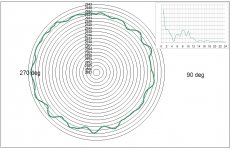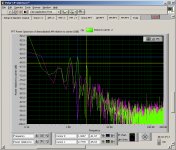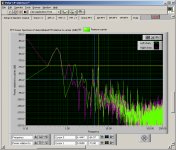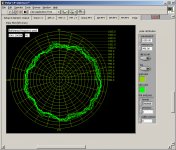It is not absolute pitch, rather pitch variation, most disturbing on pipe organ and piano music.
So that pitch variation due to off-centre record doesn't dominate in an otherwise heathy and well set up rig, it ideally needs to be set to a tolerance of +/- 0.1mm or so.
That seems to be about the absolute threshold of audibility.
Yes, solo piano is particularly good at exposing the problem.
LD
That seems to be about the absolute threshold of audibility.
Yes, solo piano is particularly good at exposing the problem.
LD
No, it's not dominate, but it sure does make an appreciable difference not unlike having a tonearm setup better.
Re-inventing the wheel
The subjective effects of pitch stability and, more specifically wow and flutter, was well researched in the mid fifties by the British Broadcasting Corporation and the Japan Broadcasting Corporation. In general, both independent studies found that the subjective threshold for the audible perception of pitch variation (frequency modulation, or ‘FM’) was a curve. When plotted against frequency the lowest part of the curve, where the ear was most sensitive to pitch variation, occurs in the region of 3-5 Hz which gets into the region of arm/cart effects, not 0.55 Hz from record eccentricity.
British Broadcasting Corporation
“Subjective Discrimination of Pitch and Amplitude Fluctuations in Recording Systems”
Published by Institution of Electrical Engineers, Sept 1955
Reprinted by the Audio Engineering Society, July 1957:
AES E-Library >> Subjective Discrimination of Pitch and Amplitude Fluctuations in Recording Systems
also researched in the same time period as the BBC study,
Japan Broadcasting Corporation
“Perceptibility of Wow and Flutter”
Published by the Audio Engineering Society, June 1970:
AES E-Library >> Perceptibility of Wow and Flutter
and recently discussed in detail here on diyaudio:
Turntable speed stabilty
The internet of things has a tendency to recycle topics that have already been well researched and documented. All too often the newest iteration is not carried out to as high a standard as the original, but the new version becomes the "I read it on the internet so it must be so".
I'm not trying to minimize the importance of centering records or discourage looking for practical solutions to the problem, but there are bigger fish to fry.
Ray K
The subjective effects of pitch stability and, more specifically wow and flutter, was well researched in the mid fifties by the British Broadcasting Corporation and the Japan Broadcasting Corporation. In general, both independent studies found that the subjective threshold for the audible perception of pitch variation (frequency modulation, or ‘FM’) was a curve. When plotted against frequency the lowest part of the curve, where the ear was most sensitive to pitch variation, occurs in the region of 3-5 Hz which gets into the region of arm/cart effects, not 0.55 Hz from record eccentricity.
British Broadcasting Corporation
“Subjective Discrimination of Pitch and Amplitude Fluctuations in Recording Systems”
Published by Institution of Electrical Engineers, Sept 1955
Reprinted by the Audio Engineering Society, July 1957:
AES E-Library >> Subjective Discrimination of Pitch and Amplitude Fluctuations in Recording Systems
also researched in the same time period as the BBC study,
Japan Broadcasting Corporation
“Perceptibility of Wow and Flutter”
Published by the Audio Engineering Society, June 1970:
AES E-Library >> Perceptibility of Wow and Flutter
and recently discussed in detail here on diyaudio:
Turntable speed stabilty
The internet of things has a tendency to recycle topics that have already been well researched and documented. All too often the newest iteration is not carried out to as high a standard as the original, but the new version becomes the "I read it on the internet so it must be so".
I'm not trying to minimize the importance of centering records or discourage looking for practical solutions to the problem, but there are bigger fish to fry.
Ray K
Hi Ray,
We all agree BUT the level of the 0.55Hz FM is often 20db above the arm cart resonances so can be the dominant audible issue.
We all agree BUT the level of the 0.55Hz FM is often 20db above the arm cart resonances so can be the dominant audible issue.
Hi Ray,
We all agree BUT the level of the 0.55Hz FM is often 20db above the arm cart resonances so can be the dominant audible issue.
If you ever listen to someone's stereo that can actually play -3db down into below 10hz, you get the full effect of how bad all of it can get. Certain records can feel like an unwanted massage. You feel, but don't hear. And they think rumble filters are bad... I guess they don't even notice it.
Hi Ray,
We all agree BUT the level of the 0.55Hz FM is often 20db above the arm cart resonances so can be the dominant audible issue.
Be sure you are comparing apples to apples. Arm/cart resonance is typically measured and quoted as amplitude. The amount of FM for a given amplitude of arm/cart resonance varies depending on arm geometry, stylus cantilever length, and VTA.
Ray K
Feel free to use what you find on the internet for $0. You get what you pay for. 😉I hate AES links, btw... I'm not paying $125 when I already know the difference in sound.
Ray K
Feel free to use what you find on the internet for $0. You get what you pay for. 😉
Ray K
To be sure any studies in the 1950's had no benefit of any software or computers for that matter.
If you ever listen to someone's stereo that can actually play -3db down into below 10hz
The 0.55Hz FM on a piano chord has nothing at all to do with low frequency cutoff.
The 0.55Hz FM on a piano chord has nothing at all to do with low frequency cutoff.
Arm cart resonances are right in the zone, and they're 20db lower than a 0.55Hz.
This is the first I've heard FM signals described in dB.
Perhaps what's being described is the amplitude of a one-half Hz signal getting picked up by a cartridge and going through a preamp, amplifier and speakers. I've seen and heard what the 10Hz arm and compliance resonance can do to move woofer cones, but I can't imagine 0.55Hz affecting anything other than the FM modulation of the program material.
Perhaps what's being described is the amplitude of a one-half Hz signal getting picked up by a cartridge and going through a preamp, amplifier and speakers. I've seen and heard what the 10Hz arm and compliance resonance can do to move woofer cones, but I can't imagine 0.55Hz affecting anything other than the FM modulation of the program material.
Arm cart resonances are right in the zone, and they're 20db lower than a 0.55Hz.
You are not understanding my comment, AM or FM at 10Hz of say a 440Hz note has no content at 10Hz unless the FM is gross.
This is the first I've heard FM signals described in dB.
Yes sloppiness is possible the FM spectrum does not parse into individual harmonics like AM but it would still be fair if one is careful with dB referred to what. For instance peak or rms deviation re carrier.
Here is an example of the FM and AM components from my Linn Axis, demodulated 1 kHz signal. The 4.16 Hz is the revolution of the motor/pulley that has a slight wobble.
Then there are FM-components at 0.55 Hz, 1.11 Hz, 1.66 Hz, 2.22 Hz, etc. Also a peak at 5.55 Hz.
Am komponents are at mainly at 1.11, 1.66, 2.77 Hz.
Then there are FM-components at 0.55 Hz, 1.11 Hz, 1.66 Hz, 2.22 Hz, etc. Also a peak at 5.55 Hz.
Am komponents are at mainly at 1.11, 1.66, 2.77 Hz.
Attachments
You are not understanding my comment, AM or FM at 10Hz of say a 440Hz note has no content at 10Hz unless the FM is gross.
I think you're not understanding mine. I get what you're saying, but what I'm saying is that a much, much lower resonances is very apparent when you can "hear" it. It's a contrast of the significance of 0.55Hz.
Without getting too caught up in what IS objectionable and what is NOT, how about this simple, one-time solution:
Hobby stores around here (middle of U.S.) and some wider-stocked hardware stores have a small display of brass, aluminum, copper tubing and sheet stock -- the company name might be 'K & R' metals. Buy some .002 or .005 inch (.051, .127 mm) sheet brass -- it comes in little 4 x 10" sheets fairly cheep. Cut some little strips, ~2 mm wide, ~2 cm long. Most records will surrender to 2 or 3 strips through the hole, folded down and Scotch-taped in place. Then you're done -- as long as you don't put it on a table with larger or smaller spindle.
Now . . if you have a record that needs .5 mm correction, I'd have to hope that it is replaceable because that would be awfully hard to enjoy.
Regards,
Rick
Hobby stores around here (middle of U.S.) and some wider-stocked hardware stores have a small display of brass, aluminum, copper tubing and sheet stock -- the company name might be 'K & R' metals. Buy some .002 or .005 inch (.051, .127 mm) sheet brass -- it comes in little 4 x 10" sheets fairly cheep. Cut some little strips, ~2 mm wide, ~2 cm long. Most records will surrender to 2 or 3 strips through the hole, folded down and Scotch-taped in place. Then you're done -- as long as you don't put it on a table with larger or smaller spindle.
Now . . if you have a record that needs .5 mm correction, I'd have to hope that it is replaceable because that would be awfully hard to enjoy.
Regards,
Rick
- Status
- Not open for further replies.
- Home
- Source & Line
- Analogue Source
- vinyl record hole off center



